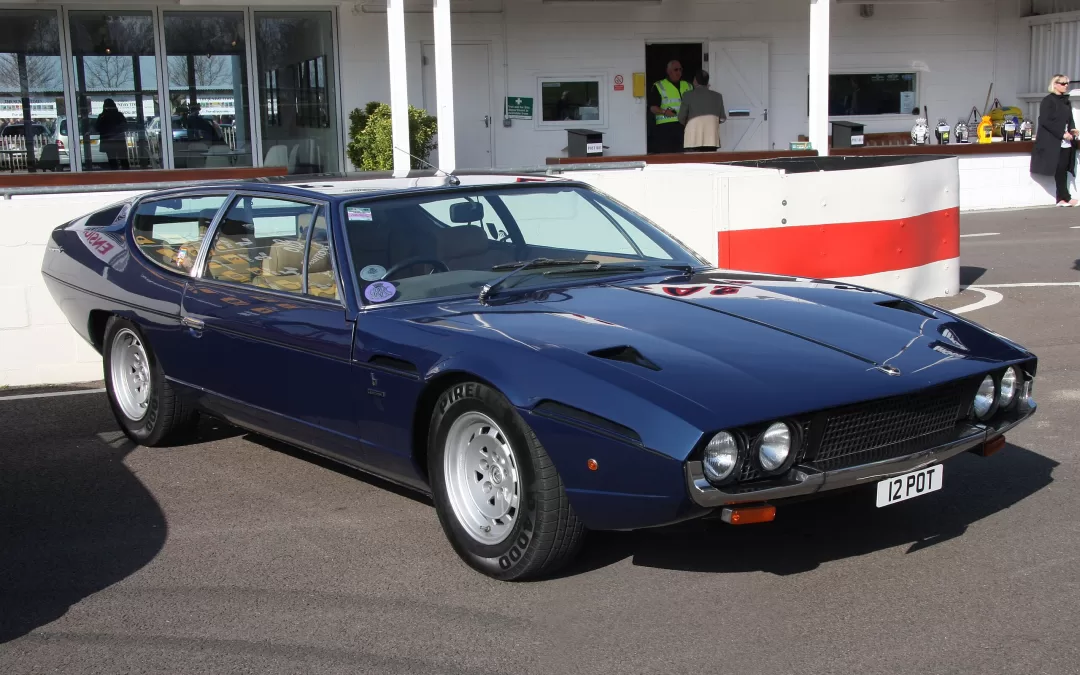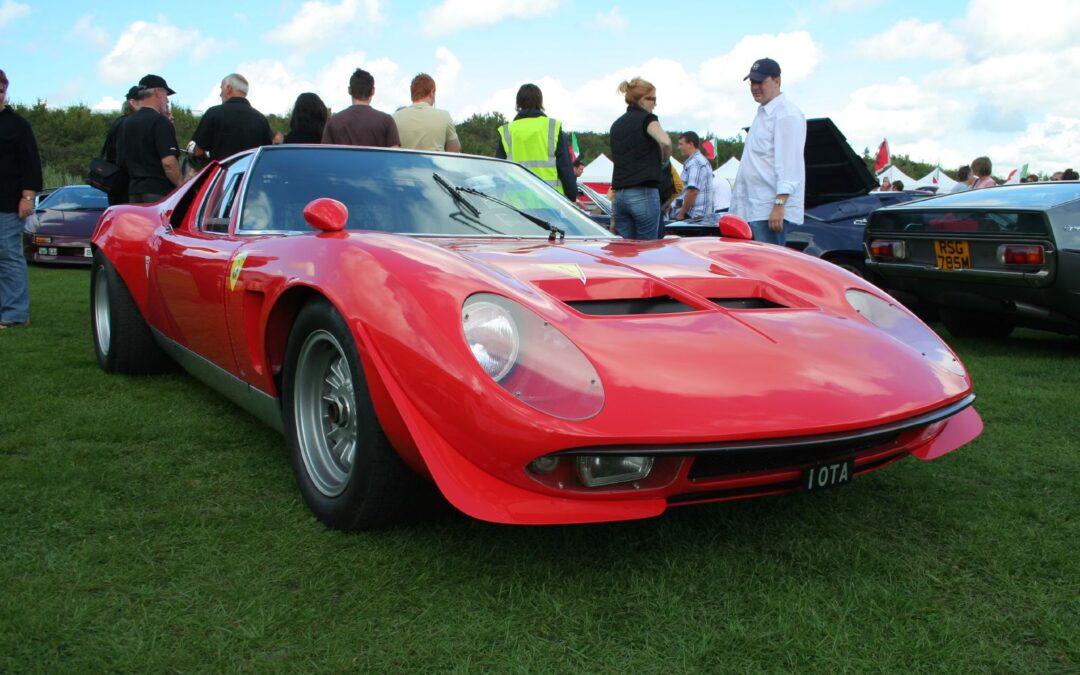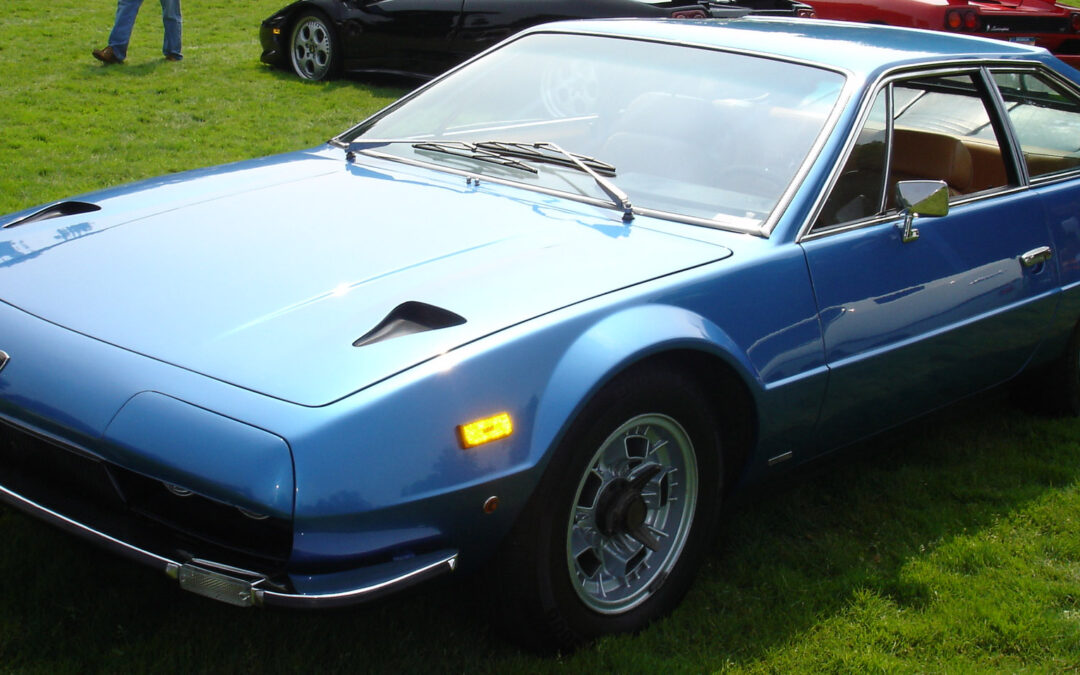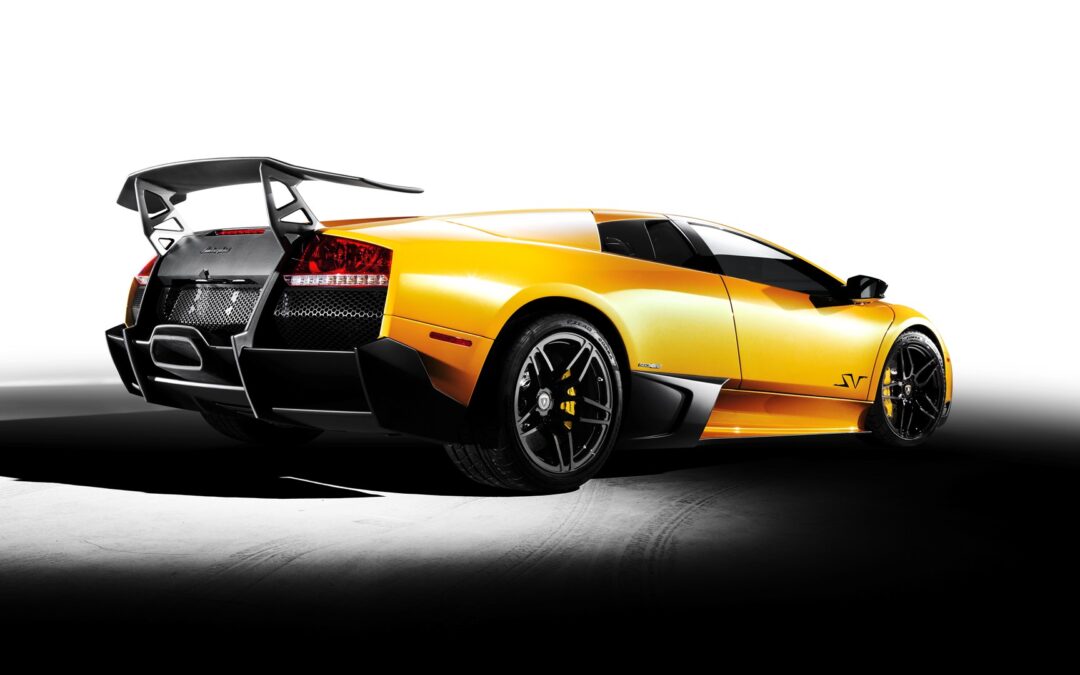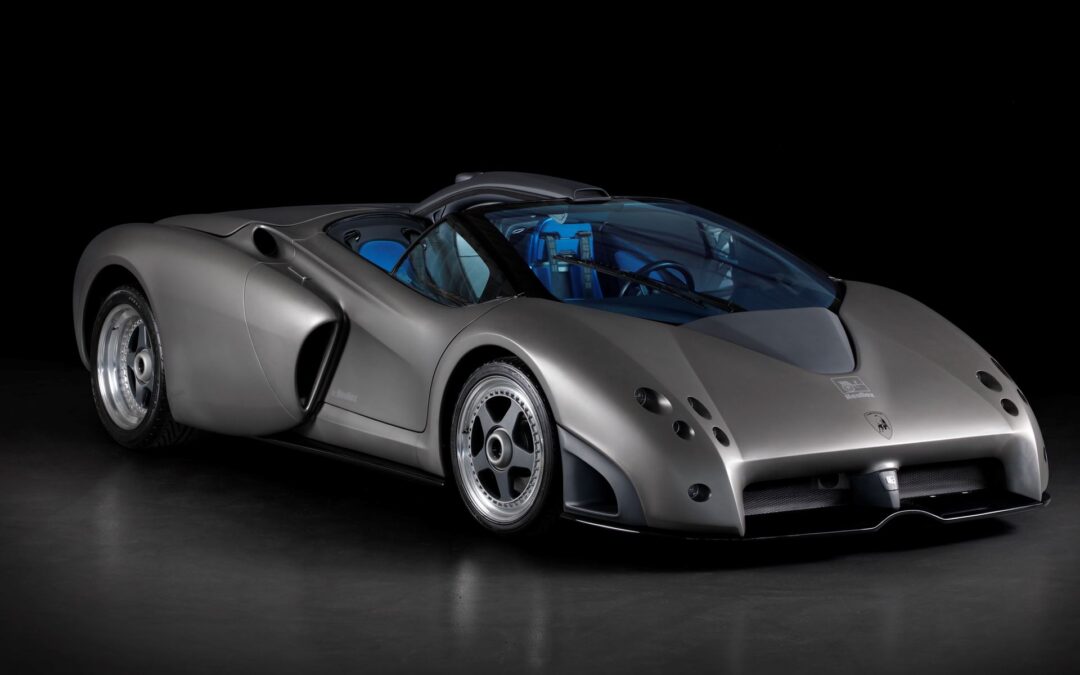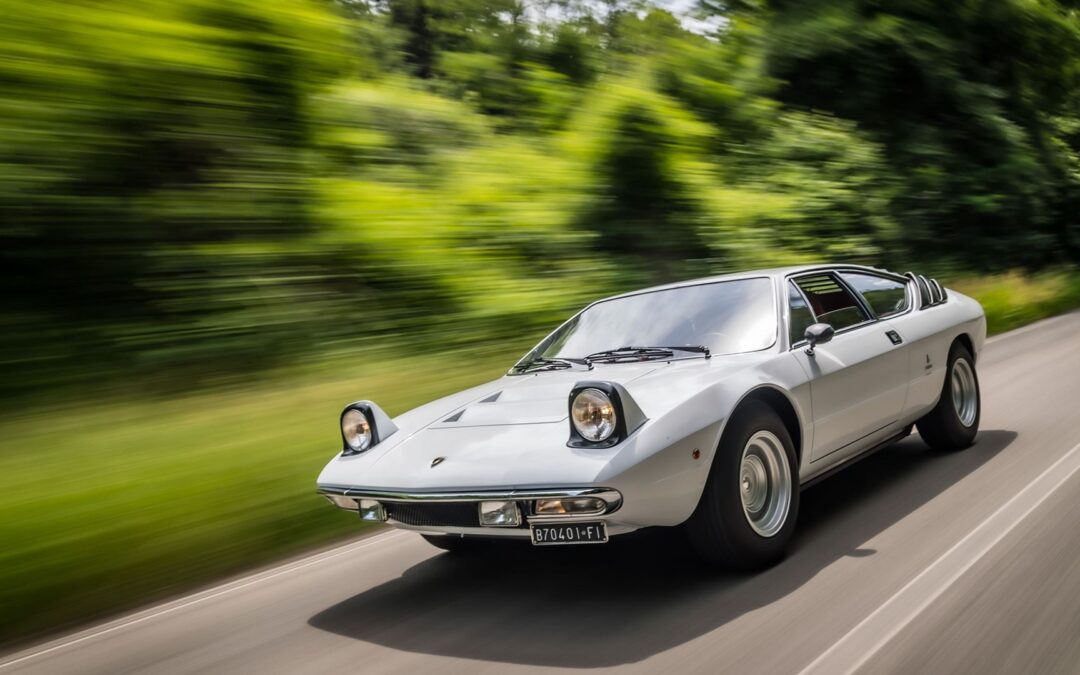
by Lamborghini Fan 1 | Oct 16, 2025 | Vintage / History
The Ultimate Analogue Hammer: Diablo at 35
Three and a half decades after its debut, Lamborghini’s V12 titan—the first production car to shatter the 200 mph barrier—proves why untamed analog terror still reigns supreme in the collector world.
In the pantheon of wedge-shaped hypercars, few machines command the simultaneous reverence and terror of the Lamborghini Diablo. As this Italian icon celebrates its 35 Anniversary, its legacy isn’t just about speed; it’s about unapologetic, analogue excess. This was the car that defined the 1990s supercar dream, mixing raw muscle with surprising technological audacity.
The Devil’s Mandate: 200 MPH or Bust
The Diablo’s mission, which began in 1985 as Project 132, was simple: replace the legendary Countach and become the fastest road car in the world. Initial sketches by Marcello Gandini were dramatic, but it was Chrysler’s brief ownership in the late 80s that refined the lines, giving the final product the muscular haunches and low-slung stance we know today.
When it launched in 1990, unveiled dramatically at the Monte Carlo Rally, the results were brutal and immediate. At its heart lay a ferocious 485HP V12 engine, an evolution of the Countach’s powerhouse.
Analogue Terror Meets Luxury
Despite its speed, the Diablo introduced a level of sophistication previously unheard of in a Sant’Agata special. Lamborghini used carbon fiber inserts (a first for the company) within the steel tubular frame, and engineered sophisticated suspension to tame the V12’s fury.
Yet, this devil had a comfortable side: adjustable seats, electric windows, and even an Alpine stereo system. This duality—brutally quick performance paired with actual luxury and the retention of the iconic scissor doors—is what made the Diablo a cultural phenomenon.
But make no mistake: the early Diablos, lacking power steering and ABS, demanded respect. As Alessandro Farmeschi, After Sales Director at Lamborghini, notes: “The Diablo is a model of growing strategic importance to Polo Storico. A new generation of collectors… see this car as a cultural and design icon,” confirming the value of preserving these untamed machines.
The Evolution of the Species
Over its eleven-year production run (1990–2001), the Diablo constantly shifted to meet new demands and new ownership:
- 1993: Viscous Traction (VT): The first V12 Lamborghini to gain All-Wheel Drive for improved stability—a feature that would become a hallmark of subsequent V12 models. The SE30 arrived the same year, pushing power to 525hp to celebrate the company’s 30th anniversary.
- 1995: VT Roadster: Lamborghini finally offered an open-top V12, with a removable targa panel.
- 1998: The Audi Revolution: Following the acquisition by Audi, the model received a major restyling. The classic pop-up headlights were replaced by fixed units, and modern systems like ABS were finally added. Displacement increased, and the final versions, culminating in the GT and the VT 6.0, featured design input from Luc Donckerwolke. The GT was the ultimate evolution, boosting power to 575hp.
This era also saw Lamborghini embrace official racing with the Diablo SV-R and the monstrous GT-R track machines, proving the V12’s endurance on the world stage.
Hollywood Hellion and Rising Star
The Diablo’s influence extended far beyond the asphalt of Nardò. It was the quintessential ’90s superstar, appearing everywhere from Jim Carrey’s famous red model in Dumb and Dumber to the cover of the Need for Speed franchise. Jay Leno, Mike Tyson, and Jamiroquai’s Jay Kay all owned one, cementing its status as a global symbol of power and luxury.
Today, the Diablo’s value is soaring. Models, especially the rare SV-R, GT, and SE30 variants, are setting records at auction. As the last truly analogue, brutally powerful V12 flagship before the Murciélago introduced a new generation of refinement, the Diablo stands as a magnificent, terrifying, and irreplaceable piece of automotive history. Thanks to Polo Storico, its legacy—and its danger—are preserved for those brave enough to hold the sword.

by Lamborghini Fan 1 | Oct 16, 2025 | Sedans / SUVs, Vintage / History
In the hallowed halls of Lamborghini, where names like Miura and Countach echo with the thunder of V12s and the sharpness of razor-edged design, there exists a curious, often overlooked beast: the Espada. Often overshadowed by its more flamboyant two-seater siblings, the Espada stands as a testament to Ferruccio Lamborghini’s initial vision – not just for outright speed, but for luxurious, high-performance grand touring. And after spending some quality time with a pristine Series III example, it’s clear this four-seater bull deserves far more than a passing glance.
A Bold Statement in Steel and Glass
Unveiled at the 1968 Geneva Motor Show, the Espada – Spanish for sword – was a radical departure for the nascent supercar manufacturer. While the Miura was redefining the mid-engined exotic, the Espada offered something almost unthinkable: a genuine four-seater that could comfortably devour continents at warp speed.
Penned by Marcello Gandini at Bertone, the Espada is undeniably a child of its era. Its silhouette is long, low, and surprisingly sleek for its substantial dimensions. The most striking feature is undoubtedly the vast expanse of glass, especially the panoramic rear window, which gives the car a unique, almost fastback-wagon aesthetic. It’s a design that dares to be different, a testament to Gandini’s willingness to push boundaries. Is it conventionally beautiful in the same way a Miura is? Perhaps not to everyone, but it possesses an undeniable presence and a futuristic allure that still turns heads today.
The Heart of a Bull, the Soul of a Tourer
Under that long, aristocratic bonnet lies the familiar heart of a Lamborghini: a magnificent 3,929 cc DOHC V12. In its initial Series I guise, it produced a healthy 325 bhp, rising to 350 bhp for the Series II and III. Mated to either a five-speed manual gearbox (the overwhelming choice for enthusiasts) or, surprisingly, a three-speed automatic, the Espada offered genuine supercar performance for its day. Top speeds nudged 150 mph, and the sprint to 60 mph was dispatched in a respectable 6.5 seconds – astounding for a car that could comfortably carry four adults and their luggage.

by Lamborghini Fan 1 | Aug 12, 2025 | Motorsports, Vintage / History
In the annals of automotive history, few cars possess a mystique as profound as the Lamborghini Miura. But within this legendary lineage, one name stands out for its tantalizing blend of performance, innovation, and tragedy: the Miura Jota. This one-off test mule, built by the brilliant development driver Bob Wallace, was a testament to what Lamborghini was truly capable of, even though the company’s founder, Ferruccio Lamborghini, famously refused to enter the world of motorsports.
The story of the Jota begins in 1970. While company founders Giotto Bizzarrini and Gianpaolo Dallara had departed after Ferruccio’s steadfast refusal to go racing, chief technical officer Paulo Stanzani and Bob Wallace remained. Stanzani gave Wallace the green light to create a track-focused Miura, a project Wallace would undertake in his own time. The goal was to build a car that would conform to the FIA’s Appendix J racing regulations, hence the name “Jota.”
Wallace’s modifications were extensive and transformative. The most significant change was a dramatic reduction in weight. He replaced steel chassis components and body panels with a lightweight aluminum alloy called Avional, and swapped out the side windows for plastic. These changes resulted in a car that weighed approximately 800 lbs (360 kg) less than a production Miura. The Jota’s exterior also received a front spoiler and fixed, faired-in headlights, and the single large fuel tank was replaced with two smaller, sill-mounted units.
Under the skin, the Jota was a different beast altogether. The suspension was reworked, and the car was fitted with wider (9″ front, 12″ rear) and lighter wheels shod with low-profile Dunlop racing tires. The engine was heavily modified to produce between 418–440 bhp (312–328 kW) at a staggering 8800 rpm. This was achieved through an increased compression ratio (from 10.4:1 to 11.5:1), altered camshafts, electronic ignition, a dry-sump lubrication system, and a less restrictive exhaust. This combination of a powerful engine and a lightweight body meant the Jota could rocket from 0-62 mph in just 3.5 seconds and reach a top speed of 190 mph. Its specific power output was an impressive 110 bhp per liter—a remarkable achievement for a naturally aspirated engine of the era.
Despite its incredible performance and track-ready design, the Jota never raced. After extensive testing by Wallace, it was sold to a private buyer in 1971. Tragically, the car’s life was cut short when it crashed on an unopened ring road around Brescia and was completely destroyed in the ensuing fire.
The legend of the Jota, however, lived on. Its destruction led to a demand for similar cars, and Lamborghini itself created a limited run of “SVJ” replicas. While these cars borrowed some of the Jota’s styling cues, they were not as highly developed and were far more civilized. The legend also inspired other one-off creations, including the “Millechiodi” and a meticulously crafted tribute built by a passionate enthusiast named Piet Pulford. This recreation, built with the help of Bob Wallace himself, took 15 years to complete and is considered to be a near-perfect facsimile of the original Jota

by Lamborghini Fan 1 | Jul 29, 2025 | Vintage / History
The Lamborghini Jarama: A Unique Chapter in Sant’Agata’s History
Often living in the shadow of its more flamboyant siblings like the Miura and Countach, the Lamborghini Jarama represents a significant, albeit often overlooked, chapter in the marque’s illustrious history. Introduced at the 1970 Geneva Motor Show, the Jarama was designed as a refined 2+2 grand tourer, a concept much favored by Ferruccio Lamborghini himself, who famously drove a Jarama S for years.
A Brief History: The Jarama was intended to be the successor to the Islero and the final evolution of Lamborghini’s front-engine, V12-powered 2+2 grand touring line. It was also specifically designed to meet stringent US safety and emissions standards, a crucial market for the Italian automaker. Styled by Marcello Gandini at Bertone, the Jarama featured sharp, angular lines that were characteristic of 1970s design, with distinctive “eyelid” covers over its headlights that gave it a unique, somewhat sleepy appearance. While its platform was a shortened version of the larger Espada’s chassis, the Jarama aimed for a more compact and sporting demeanor.
Two main versions were produced: the Jarama GT (1970-1972) and the Jarama S, or GTS (1972-1976). Both were powered by Lamborghini’s magnificent 3.9-liter (3,929 cc) V12 engine, initially producing 350 horsepower in the GT and later upgraded to 365 horsepower in the S model thanks to revised carburetors, heads, and exhaust. Power was sent to the rear wheels via a five-speed manual transmission, though a rare automatic option was also available.
Despite its powerful V12 and impressive top speed (around 160-165 mph), the Jarama faced a challenging market. Contemporary reviews sometimes criticized its interior ergonomics, heavy steering, and cramped rear seats, especially when compared to the more spacious Espada or the pure exhilaration of the Miura. Production numbers were modest, with only 177 GTs and 150 S models built, totaling just 327 units, making it one of the rarer Lamborghinis.
Review: The Unsung GT: Today, the Lamborghini Jarama is seen by many enthusiasts as an underappreciated classic. While its styling might not be as instantly iconic as the Miura, its angular design has a certain period charm. The true appeal lies in its magnificent V12 engine – a mechanical masterpiece that delivers a thrilling soundtrack and impressive performance, even by modern standards. The driving experience, though perhaps not as agile as a dedicated sports car, offers a compelling blend of power, luxury, and grand touring comfort.
The Jarama represented a pivotal point for Lamborghini, marking the end of an era for their front-engine GTs before the company fully embraced the mid-engine supercar layout with the Countach. For those who appreciate a powerful, rare, and genuinely drivable classic Lamborghini, the Jarama offers a unique and rewarding ownership experience, embodying the spirit of a true gentleman’s express from Sant’Agata. Its rarity and the increasing appreciation for its historical significance are gradually pulling it out of obscurity.

by Lamborghini Fan 1 | Jun 22, 2025 | Vintage / History
The new millennium ushered in a pivotal era for Lamborghini. With the iconic Diablo fading into history, the stage was set for its successor: the Murciélago. This wasn’t just any new model; it was the first wholly developed under Audi AG’s discerning ownership, tasked with balancing Lamborghini’s untamed spirit with newfound German engineering precision. Named, as tradition dictates, after a valiant fighting bull, the Murciélago was destined for legend.
Penned by the talented Luc Donckerwolke, the Murciélago’s design was an immediate head-turner. It retained Lamborghini’s signature scissor doors and a low, aggressive stance, yet introduced a cleaner, more angular aesthetic. Its purposeful lines, dramatic air intakes, and a rear hinting at immense power solidified its status as a visual masterpiece. The Murciélago wasn’t just a car; it was a bold statement, declaring Lamborghini’s return, stronger and more refined, ready to redefine supercar benchmarks.
Beneath that striking skin beat the heart of a true beast: a 6.2-liter V12 engine. In its original form, this powerhouse roared with 572 horsepower, catapulting the Murciélago from 0 to 60 mph in a blistering 3.8 seconds and towards a top speed exceeding 200 mph. An advanced all-wheel-drive system managed its raw power, ensuring formidable grip. Innovative features like active air intakes, which opened based on engine temperature and speed, blended performance engineering with theatrical flair, making it truly unique.
The Murciélago evolved impressively from its 2001 debut to its 2010 farewell. The most notable upgrade arrived in 2006 with the LP 640, boosting power to 631 hp and refining its aerodynamics and interior. A Roadster variant offered open-air V12 symphony, while limited editions like the LP 650-4 Roadster added exclusivity. The pinnacle of the lineage was the 2009 LP 670-4 SuperVeloce. Lighter, more potent (661 hp), and clad in aggressive carbon fiber, the SV was a track-focused monster, pushing the Murciélago’s performance to its absolute limit.
Beyond its raw power and breathtaking design, the Lamborghini Murciélago etched itself into popular culture. It became the quintessential poster car, gracing blockbuster films, high-profile music videos, and countless video games. Its dramatic presence and unmistakable V12 roar made it instantly recognizable, cementing Lamborghini’s reputation for crafting audacious, uncompromising machines. It transcended mere transportation, becoming a symbol of automotive artistry and visceral power.
When the final Murciélago, the 4,099th unit, rolled off the Sant’Agata Bolognese line in 2010, it marked the end of an era. This magnificent V12 beast had successfully steered Lamborghini through its crucial transition under Audi, establishing a modern foundation while fiercely honoring its wild heritage. Its successor, the Aventador, had monumental shoes to fill, but the Murciélago’s legacy as a successful, iconic, and undeniably thrilling supercar was secure, forever a powerful chapter in Lamborghini’s storied history.

by Lamborghini Fan 1 | Apr 24, 2025 | Etcetera, Vintage / History
The late 1990s. The air crackled with technological advancement, and the automotive world was no exception. Amidst the roar of established supercars, a whisper emerged from Sant’Agata Bolognese – a concept car so radical, so audacious, it left enthusiasts breathless. This was the Lamborghini Pregunta, a name that translates to “question” in Spanish, and indeed, it posed a fascinating “what if?” to the future of Lamborghini.
Imagine a machine stripped bare, honed for pure speed and visceral driving pleasure. The Pregunta wasn’t about opulent interiors or everyday practicality; it was a focused instrument, a glimpse into Lamborghini’s potential foray into the realm of ultra-high-performance, track-inspired road cars. Unveiled at the 1998 Paris Motor Show, it was a stark departure from the Diablo that was then the marque’s flagship.
Its design was undeniably striking. Gone were the softer curves; in their place, sharp angles and aggressive lines dominated. The low-slung profile, the prominent rear wing, and the almost fighter-jet-like cockpit screamed purpose. Penned by Heuliez, a French coachbuilder, the Pregunta borrowed heavily from contemporary Formula 1 aesthetics. The exposed carbon fiber elements hinted at its lightweight construction, a crucial factor in achieving its performance goals. The matte grey paint, the same used on the Dassault Rafale fighter jet, further emphasized its aviation inspiration.
Beneath the dramatic skin lay the heart of a beast – a naturally aspirated 5.7-liter V12 engine, the same magnificent unit found in the Diablo SV. However, in the Pregunta, it was rumored to have been tweaked to produce even more power, pushing beyond the 530 horsepower mark to a claimed 530 bhp at 7100 rpm. The torque figure was equally impressive at 446.2 ft lbs at 5500 rpm. Unlike the Diablo’s all-wheel-drive system, the Pregunta channeled its power exclusively to the rear wheels through a 5-speed manual transmission, contributing to its lighter weight of around 1650 kg (3638 lbs).
Coupled with a lightweight chassis and advanced aerodynamics, the projected performance figures were staggering. Talk circulated of a top speed exceeding 333 km/h (207 mph) and a 0-100 km/h (0-62 mph) sprint in a mere 3.9 seconds – numbers that would have placed it firmly in the hypercar echelon of its time, even rivaling the Ferrari F50 in terms of power output.
Stepping inside the Pregunta would have been an exercise in focused minimalism. The emphasis was clearly on the driver. Racing bucket seats, a digital instrument cluster sourced from Formula 1 by Magnetti Marelli, and a spartan dashboard reinforced the car’s track-oriented nature. Rear-view mirrors were replaced by cameras with integrated screens, and a GPS navigation system was present, further echoing its fighter jet inspiration. The interior featured a striking blue dashboard and seats, contrasted by grey elements.
However, the Lamborghini Pregunta remained just that – a question, a concept. Despite the buzz and the drooling admiration it garnered at the 1998 Paris Motor Show and the 1999 Geneva Motor Show, it never entered series production. Lamborghini, under different ownership at the time, likely deemed the project too niche or perhaps not aligned with their immediate strategic direction as Audi took over the company around this period. It is believed that Lamborghini’s intention with the Pregunta was also to celebrate the 50th anniversary of their participation in the Paris Motor Show.
Only one Pregunta was ever officially built by Heuliez in collaboration with Lamborghini. Following its debut and Audi’s acquisition of Lamborghini, the rights to the car’s design were not sold, making it an exceptionally rare one-off. It eventually found its way into private hands, becoming a highly sought-after and incredibly rare piece of Lamborghini history. In 2013, this unique machine was listed for sale at around €1.6 million, highlighting its desirability among collectors.
Today, the Lamborghini Pregunta serves as a tantalizing reminder of a road not taken, a glimpse into a potentially more hardcore and track-focused future for the raging bull. While Lamborghini continued to produce formidable supercars, the Pregunta’s radical spirit and uncompromising focus on performance remain a unique and captivating chapter in the brand’s storied legacy. It begs the question: what if Lamborghini had dared to answer “yes” to the Pregunta? The automotive landscape might look very different today, potentially seeing a more direct lineage to hypercars from Sant’Agata before models like the Reventón and Veneno emerged much later, taking inspiration from its bold design.
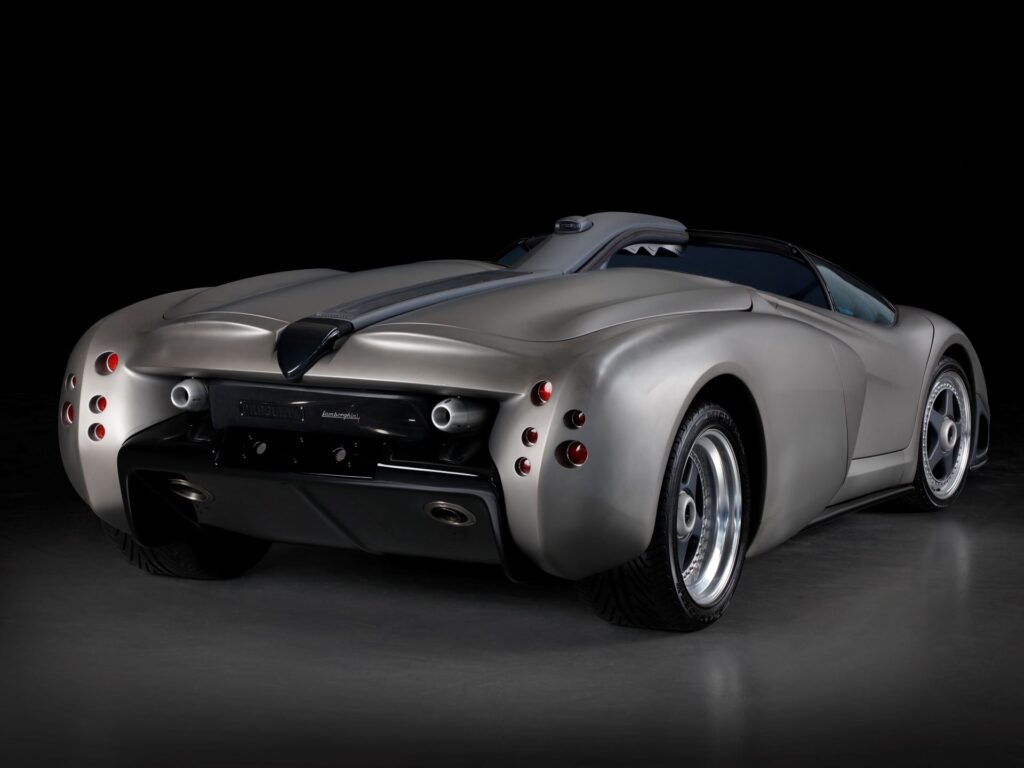

by Lamborghini Fan 1 | Apr 18, 2025 | Sedans / SUVs, Vintage / History
A Bull in the Bush
In the annals of automotive history, certain vehicles arrive not merely as transportation, but as seismic shifts. The Lamborghini LM002, unleashed upon an unsuspecting world in 1986, was such a vehicle. At a time when the term “luxury SUV” was barely a whisper, Lamborghini, the purveyor of sleek, low-slung supercars, dared to defy convention, birthing a four-wheeled behemoth that was as audacious as it was groundbreaking.
The LM002’s origin story is as unconventional as the vehicle itself. Born from a failed military contract, this brute was initially conceived for combat, not carpool lines. Lamborghini’s engineers, their ambitions undeterred, repurposed their creation for civilian consumption. What emerged was a startling chimera: the heart of a Countach, the soul of a desert raider, and the swagger of a rock star.
A Dichotomy of Decadence
The LM002 was a study in contrasts. Its exterior, all sharp angles and imposing presence, was a far cry from the sculpted curves of its supercar brethren. This was a vehicle designed to conquer terrain, not turn heads on Rodeo Drive. Yet, step inside, and a different world awaited. Leather-clad opulence, wood trim, and a premium sound system cocooned occupants in unexpected luxury. It was a vehicle that could ford a river by day and valet park at the opera by night.
The Power Within
At the LM002’s core resided the legendary Lamborghini V12 engine, the same powerhouse that propelled the Countach to warp speed. While slightly detuned for off-road duty, it still delivered a visceral surge of power that could propel this three-ton titan to speeds that defied logic. This was no ordinary SUV; it was a supercar on stilts, a testament to Lamborghini’s engineering prowess and a harbinger of things to come.
A World Playing Catch-Up
In the late 1980s, the LM002 was an anomaly, a conversation starter, a head-scratcher. Automotive journalists grappled to categorize it. Was it a truck? An SUV? A status symbol? The answer, it turned out, was all of the above, and yet, none of them quite captured its essence.
Fast forward to today, and the automotive landscape is awash in luxury SUVs. Every manufacturer, from Bentley to Rolls-Royce, now offers a high-riding hauler, a testament to the prescience of the LM002. What was once an outlier is now the norm.
Legacy of the Rambo Lambo
The Lamborghini LM002 was more than just a vehicle; it was a statement. It was a declaration that Lamborghini could defy expectations, challenge conventions, and create a vehicle that was as comfortable in the desert as it was on the доро́га. It was a vehicle that was, in a word, ahead of its time.
Today, the LM002 enjoys a cult following among collectors and enthusiasts. Its rarity, its audaciousness, and its sheer presence ensure its place in automotive history. It is a reminder that sometimes, the most revolutionary ideas are born not from market research, but from a willingness to break the mold and forge one’s own path. And while Lamborghini has recently returned to the SUV segment with the Urus, the LM002 remains the untamed ancestor, the original bull that dared to roam where no supercar had gone before.

by Lamborghini Fan 1 | Apr 18, 2025 | Vintage / History
In the pantheon of raging bulls from Sant’Agata Bolognese, the Lamborghini Islero often stands slightly in the shadows, a more subtle and perhaps less flamboyant figure compared to its dramatic contemporaries like the Miura and Espada. Yet, this elegant 2+2 grand tourer, produced between 1968 and 1969, holds a unique and significant place in Lamborghini’s history, embodying Ferruccio Lamborghini’s personal vision of a refined yet potent Italian express.
Launched at the 1968 Geneva Motor Show as a direct successor to the 400 GT, the Islero aimed to offer a more comfortable and driver-focused experience without sacrificing the raw power that defined Lamborghini. Its name, like many of its stablemates, was derived from a legendary fighting bull – the very Islero that tragically ended the career of the famed matador Manuel Rodriguez “Manolete” in 1947, a testament to the car’s underlying ferocity.
A Departure in Design:
While its predecessors boasted elegant, curvaceous Touring coachwork, the Islero, penned by Mario Marazzi of Carrozzeria Marazzi (a firm established by ex-Touring employees), adopted a more angular and contemporary design language. The long bonnet, a hallmark of classic GT proportions, flowed into a sharply creased five-window cockpit. Pop-up headlights, a trendy feature of the era, punctuated the clean front fascia, while the slab-sided flanks contributed to a sense of understated muscularity. Though some contemporary critics found the styling less dramatic than other Lamborghinis, the Islero’s design has aged gracefully, now appreciated for its elegant simplicity. Ferruccio Lamborghini himself reportedly dictated many of the design requirements, desiring a more discreet grand tourer.
The Soul of a Lamborghini:
Beneath the Islero’s relatively demure exterior lay the heart of a true Lamborghini: the magnificent 3.9-liter, quad-cam V12 engine, inherited from the 400 GT and also found in the iconic Miura. Fed by six Weber carburetors, this glorious power unit initially produced a healthy 325 horsepower, providing effortless performance and a spine-tingling soundtrack. Mated to a smooth five-speed manual transmission and underpinned by a fully independent suspension, the Islero offered a compelling blend of high-speed cruising ability and surprisingly agile handling for a car of its size.
The Enhanced Islero S:
In 1969, Lamborghini introduced the Islero S, a refined and more potent evolution. Power from the V12 was bumped to 350 horsepower, thanks to hotter cams and a higher compression ratio, bringing its performance figures even closer to the Miura. Visually, the S gained subtle yet significant updates, including slightly flared wheel arches, a larger hood scoop for improved cabin ventilation, and stylish horizontal vents behind the front wheels. Inside, the Islero S featured a revised dashboard and more supportive seats, enhancing the driving experience.
A Rarity with a Pedigree:
Despite its impressive capabilities and the personal endorsement of Ferruccio Lamborghini, who reportedly used an Islero as his personal car, production numbers remained low. Only 125 examples of the original Islero were built, followed by a mere 100 units of the improved Islero S before it was replaced by the Jarama in 1970. This limited production run contributes significantly to the Islero’s rarity and desirability among collectors today.
The Forgotten Bull No More:
For years, the Lamborghini Islero was often overshadowed by its more extroverted siblings. However, discerning enthusiasts are increasingly recognizing its unique charm and significance. It represents a fascinating chapter in Lamborghini’s history, showcasing the brand’s ability to create a sophisticated and powerful grand tourer that appealed to a different kind of buyer – one who appreciated understated elegance as much as thrilling performance. The Islero, the bull that felled a legend, is finally stepping out of the shadows and into the well-deserved admiration of the automotive world.

by Lamborghini Fan 1 | Apr 16, 2025 | Vintage / History
Lamborghini. The name conjures images of fire-breathing bulls, razor-sharp angles, and ear-splitting roars. We drool over the Countach, revere the Miura, and now find ourselves captivated by the Revuelto. But nestled between these legendary beasts, a lesser-known gem exists, quietly whispering its own tale of rebellious innovation: the Lamborghini Urraco.
Often overshadowed by its more flamboyant siblings, the Urraco represents a pivotal moment in Lamborghini’s history. Launched in 1970, it was Ferruccio Lamborghini’s vision for a more accessible, more practical, yet still undeniably Lamborghini sports car. He wanted to capture a broader market, offering something less extreme than the supercar titans while retaining the brand’s core DNA. The Urraco was meant to be a disruptive force, a “baby Lamborghini” for a new generation.
And disruptive it was. Designed by Marcello Gandini of Bertone, the Urraco showcased a striking, wedge-shaped profile, a hallmark of the era, but with a unique twist. Its clean lines, pop-up headlights, and integrated rear spoiler gave it a distinctly modern aesthetic, even by today’s standards. It was a departure from the curvaceous forms of its predecessors, hinting at the angular future of Lamborghini design.
Under the hood, or rather, behind the seats, resided a transversely mounted 2.5-liter V8. This smaller displacement engine, while less potent than the monstrous powerplants found in other Lamborghinis, still packed a punch. Initially producing around 220 horsepower, it offered a thrilling driving experience, especially when paired with the Urraco’s relatively light weight and nimble handling. Later iterations, like the P200 and P300, offered smaller and larger engines, respectively, to cater to different markets and performance preferences.
The Urraco’s interior, while spartan compared to modern luxury cars, exuded a certain charm. The simple dashboard layout, the leather-wrapped steering wheel, and the supportive bucket seats created a driver-focused environment. It wasn’t about opulent comfort; it was about the pure joy of driving. The Urraco was designed to connect the driver to the machine, providing a visceral and engaging experience.
However, the Urraco’s journey wasn’t without its challenges. Production delays, quality control issues, and the global oil crisis of the 1970s hampered its initial success. It struggled to compete with established rivals, and ultimately, production ceased in 1979 after just over 790 examples were built.
Despite its relatively short lifespan and its initial struggles, the Urraco has since gained a cult following. Collectors appreciate its unique design, its historical significance, and its engaging driving dynamics. It represents a different side of Lamborghini, a more approachable and perhaps more relatable side. It’s a reminder that Lamborghini isn’t just about raw power and extravagant styling; it’s also about innovation, passion, and the pursuit of driving pleasure.
The Urraco might not be the first Lamborghini that comes to mind, but it deserves a place in the brand’s pantheon of legends. It’s a testament to Ferruccio Lamborghini’s vision, Marcello Gandini’s design prowess, and the enduring spirit of the raging bull. It’s a car that dared to be different, a car that whispered when others roared, and a car that continues to captivate enthusiasts decades later. In the world of Lamborghini, the Urraco might be the unsung hero, but its melody is one that resonates deeply with those who appreciate automotive artistry and the thrill of the drive.
Units produced
- P250 Urraco: 1970-1976: 520
- P200 Urraco: 1974-1977: 66
- P300 Urraco: 1975-1979: 190


